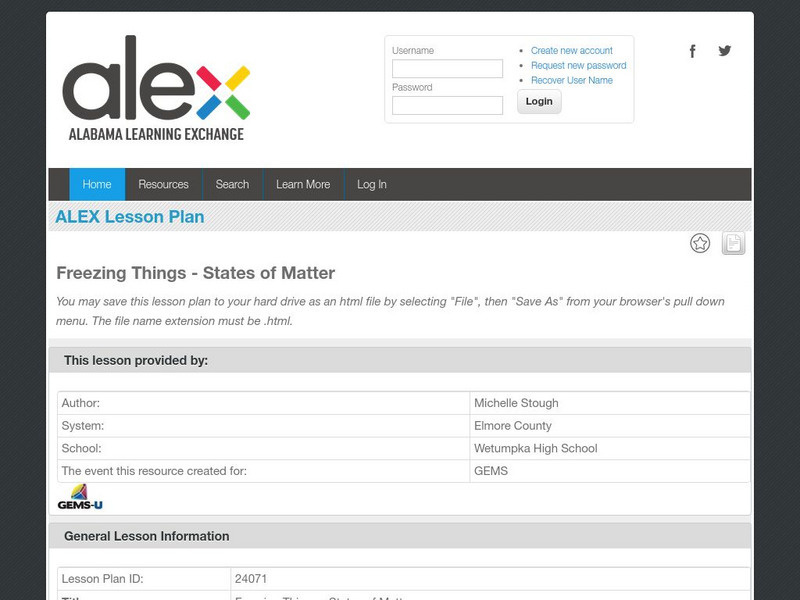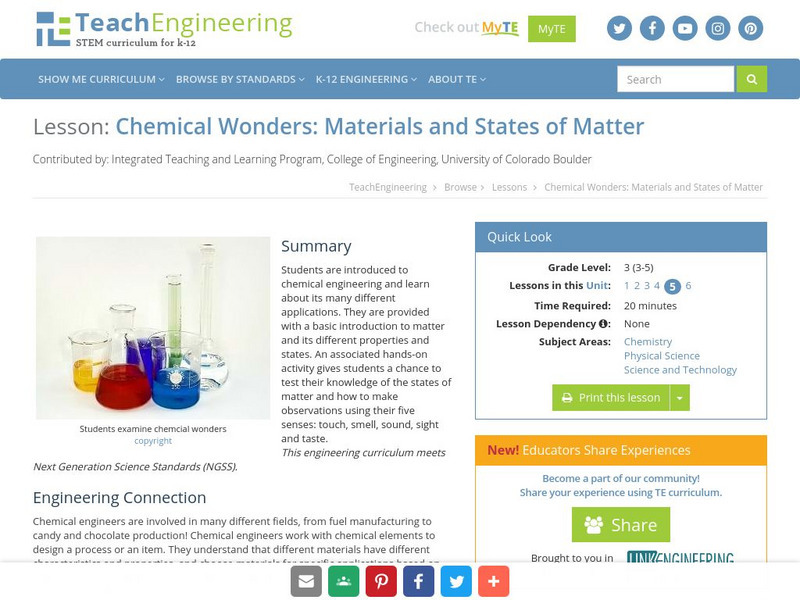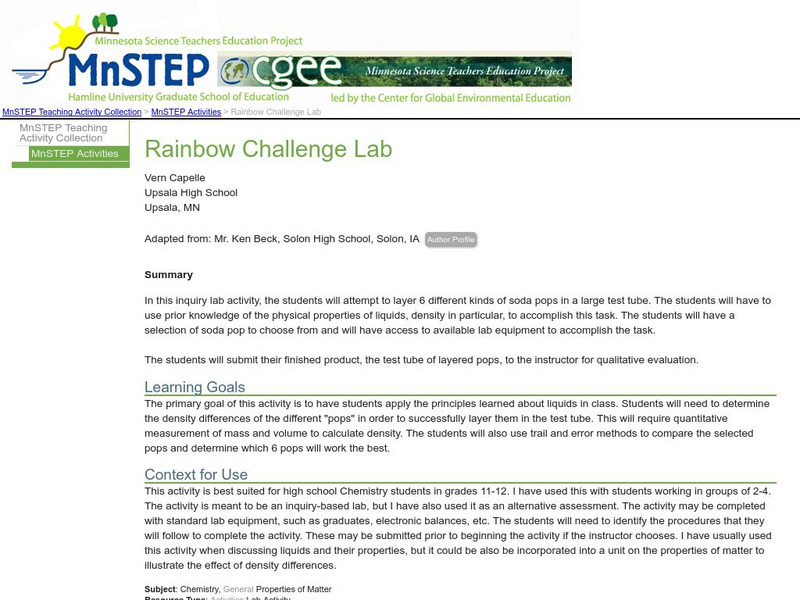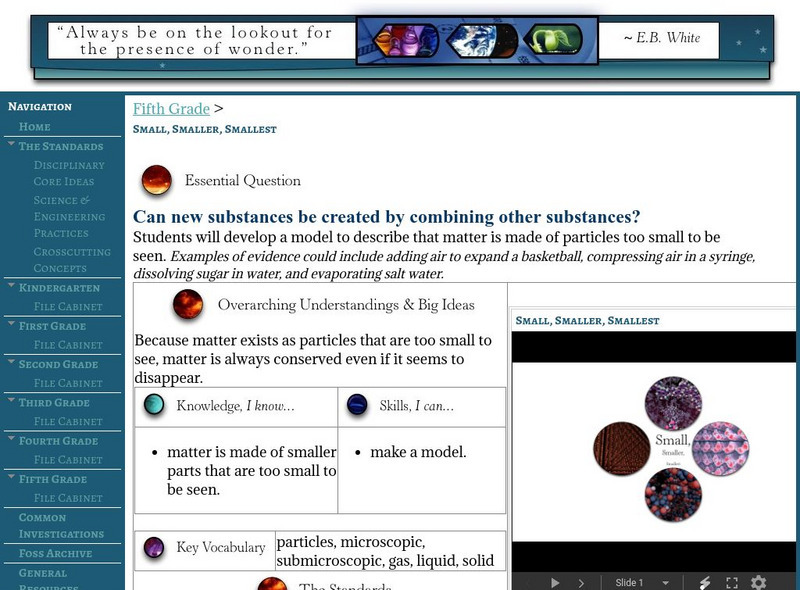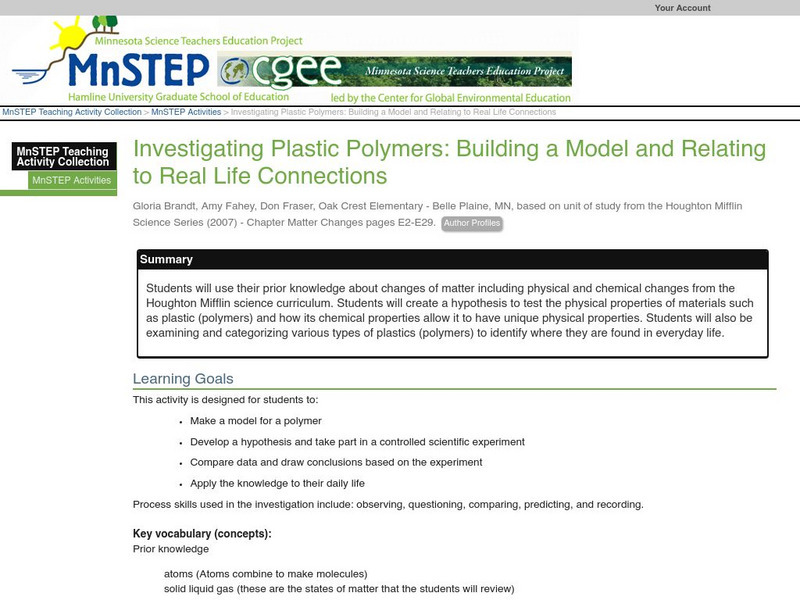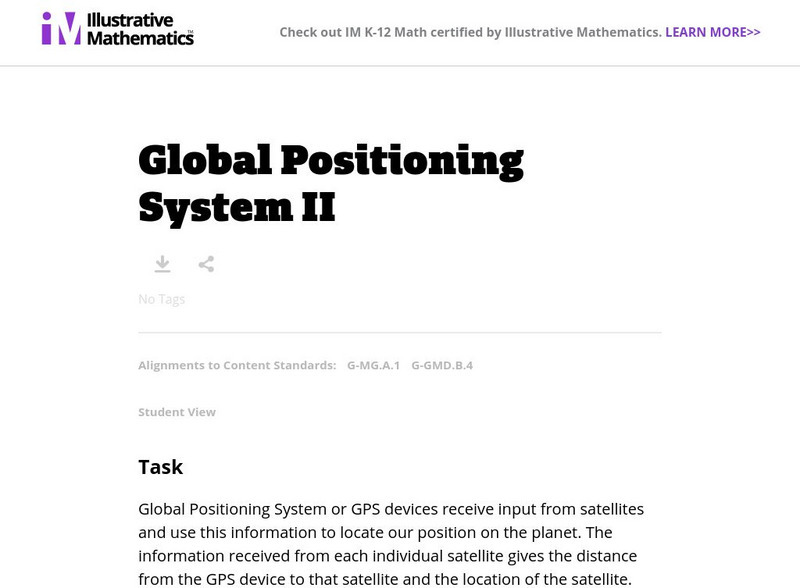Curated OER
Air Pressure
Fourth graders observe a demonstration experiment showing air pressure. They explain air pressure by completing the worksheet.
Curated OER
How Can You Study Things You Can’t See Like: Atoms?
Students simulate how scientists studied things they can't see like atoms. In this chemistry lesson, students predict what is inside the numbered obsertainers. They design a way to investigate what's inside without opening it.
Science and Mathematics Initiative for Learning Enhancement (SMILE)
Smile: Three States of Matter
Teachers can find an interactive lesson plan for introducing the three states of matter to the early elementary student using items that they are familiar with. This also includes gathering data and filling in a table, an important part...
NASA
Nasa: Light but Strong
Use these lessons from NASA to teach multiple Next Generation Science Standards for grades K-5. Properties of matter and engineering design are the focus of these lessons. Detailed plans and student handouts are included. [PDF]
Alabama Learning Exchange
Alex: Freezing Things: States of Matter
The class will go back over the Power Point presentation on chemical and physical properties. The teacher will then conduct numerous liquid nitrogen demos. This lesson is used early in the Chemistry course. The students love it. This...
American Chemical Society
Middle School Chemistry: Molecules Matter
Students observe and discuss water on the molecular level using the idea that water is composed of tiny molecules that are attracted to one another.
TeachEngineering
Teach Engineering: Chemical Wonders
Students are introduced to chemical engineering and learn about its many different applications. They are provided with a basic introduction to matter and its different properties and states. An associated hands-on activity gives...
Science Education Resource Center at Carleton College
Serc: Measuring and Comparing Matter
In this activity, students will measure a variety of different materials from the classroom to determine how much matter is found in these materials then determine the mass of these materials using the same volume for each. The data will...
University of Texas at Austin
The University of Texas Mc Donald Observatory: Spectroscope
This lesson plan guides students to build a spectroscope, use it as a tool, and interpret their observations by applying concepts of conservation of energy and properties of matter.
TeachEngineering
Teach Engineering: Antimatter Matters
Antimatter, the charge reversed equivalent of matter, has captured the imaginations of science fiction fans for years as a perfectly efficient form of energy. While normal matter consists of atoms with negatively charged electrons...
Science and Mathematics Initiative for Learning Enhancement (SMILE)
Smile: Gases Lighter and Heavier That Air
Teachers, to demonstrate to the elementary student that some gases are heavier than others, this experiment uses Winnie the Pooh and balloons to do just that.
American Chemical Society
Middle School Chemistry: What Is Density?
Calculate the density of cubes made of different materials to determine what type of material it contains. Using this information explain that the size, mass, and arrangement of the atoms or molecules of a substance determines its density.
Alabama Learning Exchange
Alex: How Sweet It Is
As part of the study of Matter, the students will determine the density of standard percent sugar solutions through hands on experimentation. In laboratory groups, students will graph a standardized curve of the experimental data. The...
PBS
Pbs Learning Media: The Ruff Ruffman Show: Teacher's Guide: Kitchen Chemistry
Learn about kitchen chemistry alongside Ruff Ruffman. Students can use the videos, games, and activities from The Ruff Ruffman Show to discover how by investigating solids and liquids and exploring heating and cooling, science can help...
TeachEngineering
Teach Engineering: Viscous Fluids
Students are introduced to the similarities and differences in the behaviors of elastic solids and viscous fluids. Several types of fluid behaviors are described--Bingham plastic, Newtonian, shear thinning and shear thickening--along...
Science Education Resource Center at Carleton College
Serc: Plastic Polymers: Investigating Their Flexibility
Students will use their prior knowledge about changes of matter to develop a hypothesis to test the physical properties of materials such as plastic (polymers) and how its chemical properties allow it to have unique physical properties.
Other
Rooted and Growing: Kindergarten Science Unit: Objects and Materials [Pdf]
A collection of science lessons where students explore the characteristics of different materials and everyday objects and create their own objects and art. They study the properties of the materials that make them strong, absorptive,...
Science Education Resource Center at Carleton College
Serc: Rainbow Challenge Lab
In this inquiry lab activity, learners will attempt to layer 6 different kinds of soda pops in a large test tube using their knowledge of density and other physical properties of liquids.
TeachEngineering
Teach Engineering: Flocculants: The First Step to Cleaner Water!
Students experience firsthand one of the most common water treatment types in the industry today, flocculants. They learn how the amount of suspended solids in water is measured using the basic properties of matter and light. In...
Science Education Resource Center at Carleton College
Serc: Polymers & Plastics: Classification & Models
Students will use their prior knowledge about changes of matter including physical and chemical changes to examine and categorize various types of plastics (polymers). They will identify how their chemical properties allow them to have...
Utah STEM Foundation
Utah Stem Action Center: What's Up With Our Air?
Young scholars will use modeling to understand inversions. Their models will evolve as they gather more information.
National Academies of Sciences, Engineering, and Medicine
National Academies Press: Small, Smaller, Smallest
View these slides to better understand that matter is made of smaller parts that are too small to be seen. These slides can be used to meet math, science, and literacy standards.
Science Education Resource Center at Carleton College
Serc: Investigating Plastic Polymers: Building a Model
Students will use their prior knowledge about changes of matter including physical and chemical changes from the Houghton Mifflin science curriculum. Students will create a hypothesis to test the physical properties of materials such as...
Illustrative Mathematics
Illustrative Mathematics: G Mg, G Gmd Global Positioning System Ii
Satellites communicate with a GPS device and establish the distance between them and their locations. The set of points at a fixed distance from a satellite form a sphere so when the GPS receives its distance from a given satellite, this...




